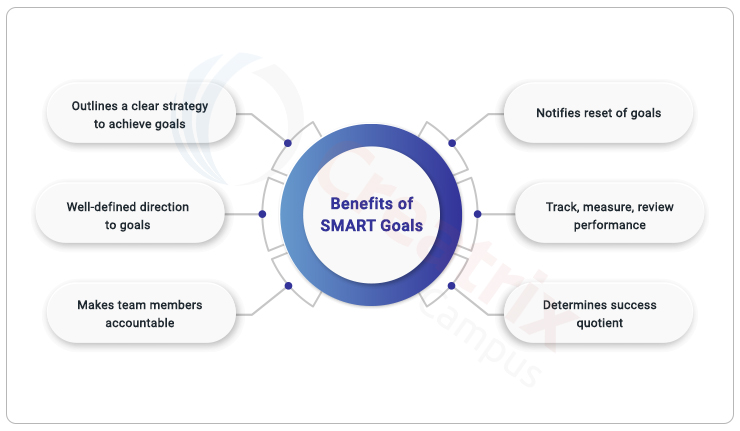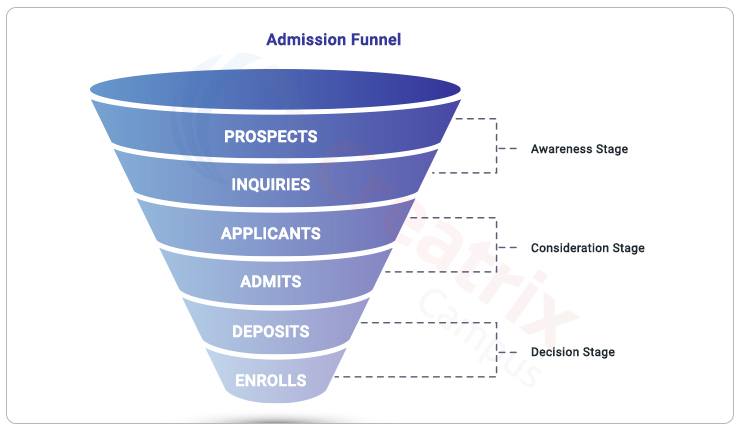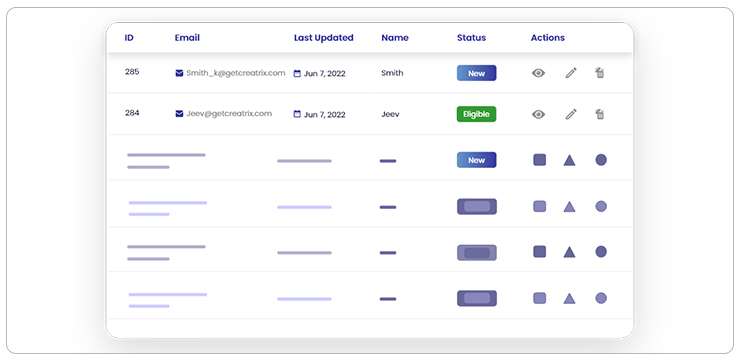Guide to setup SMART Goals in your Enrollment and Admission Strategy

The Center for American Progress statistics revealed a shocking fact that the annual undergraduate enrollment at all higher education institutions declined by 1.25 million students between the years 2014-15 and 2018-19, which was a drop by 5 percent. The same scenario was reported in public colleges with 425,000 students, hitting a 2.5 percent drop. In such a scenario, how do admission officers hit their enrollment goals? How can they examine potential students' applicants, effectively engage, and entice them to enroll in their respective institutions?
It even left us wondering if there’s a way to help them achieve their enrollment targets? Yes, and we found it. SMART goals. After all, we’re Admission and Enrollment automation experts.
Our goal is to help higher education institutions achieve their institutional goals.
So, we decided to put together an easy-to-follow guide for institutional admission managers to achieve their admission and enrollment goals through SMART goals.
What are the 5 SMART goals?
Specific, Measurable, Attainable, Relevant, and Time-bound goals are the five SMART goals. The SMART goals criteria were first established by George T. Doran in his issue of Management Review (1981). It is a school of thought that holds that all business objectives should be: Specific → Measurable → Achievable → Relevant → Time-bound.

Though this was originally the acronym, over the years, other companies and experts have offered their own modifications that put a new spin on the criterion, such as substituting Achievable for Aspirational or Actionable and Timely instead of Time-bound.
Why should you set up SMART goals for admission and enrollment purposes?
By defining SMART marketing goals, you can split even the most challenging enrollment targets into specific, actionable goals, and find a way to achieve them by regularly monitoring the progress, easily attracting your institution’s best-fitting students, and meeting your enrollment goals, just in a snap.
Examples of SMART Goals for admission and enrollment officer
Specific goals:
These goals have to be Specific. “We will increase enrollments”, can be a specific goal, but it will trigger questions like;
- How many more enrollments?
- On which courses and programs?
- By when?
That’s when the other elements of SMART goals come in…
Measurable goals:
It is critical to ensure that your team's effectiveness can be monitored, especially in results-driven areas like student recruiting and digital marketing, the measurable goals are just for that!
When we talk about measuring goals, it can take two forms: physical outcomes that clearly prove that you have met your goal or key performance indicators (KPIs) that serve as markers that you are making progress.
Therefore rather than just saying “We will increase enrollments”, your measurable goal can be “We will improve our average enrollment rate by 15%”.
This provides your team a chance to measure its success.
Attainable goals:
Attainable goals are those that are realistic. So if your team has increased enrollments by 4% in the previous years, do not just jump to 20% suddenly. It might not be attainable. Simultaneously make sure you work on tactics to increase enrollments to achieve results.
For instance, if you have been using Google advertising to run campaigns, your goal can be like “We will use Google Ads to increase enrollments by 15%.” By ensuring that you set a reasonable aim that is supported by adequate resources, those in your recruitment team will feel like they are being given a fair challenge that they will be encouraged to complete.
Relevant goals:
Any goal you set should result should be of a meaningful benefit to your student recruitment efforts. Failing to focus on relevancy may lead you to waste time and your resources.
Therefore make your goal relevant! An example could be, “We will use social media ads to boost enrollments in our undergraduate degree programs by 10%.”
Time-bound goals: This final step is self-explanatory. Whatever your goal is, it must be tied to a particular timeline that your team is willing to commit to meeting within.
Therefore this goal can be, “We will use Facebook advertising to increase enrollments in our degree programs by 10% by the new academic year.”
Benefits of setting goals in higher education enrollment strategy

- It establishes a clear strategy to achieve goals
- You and your team know precisely what is to be accomplished
- Gives clarity and a well-defined direction on how to achieve institutional success
- You get more accountable team members
- It serves as a continual progress report on how well you are progressing toward your goals
- It determines what constitutes the achievement of success for you
- It notifies you when it is time to reset your goals
- Helps to track, measure, and review your performance
- Ensures your and your team has everything to achieve your goals smartly
How to create SMART goals in admission and enrollment marketing strategy?
We'll look at what the SMART goal-setting process for enrollment managers should look like. But first, let's go over higher education enrollment funnels again so you grasp the relationship between each stage of the funnel and your related goals.
What is an enrollment and admission funnel?
The enrollment funnel reflects the various stages of a prospect's college decision-making journey. It is usually divided into six stages: Prospects, Inquiries, Applicants, Admits, Deposits, and Enrolls.
The student applicants will require various information from colleges and universities depending on the level they are in, hence marketing strategies will alter dramatically from one stage to the next.

Now, let's look at the stages of the student journey in your enrollment funnel and further down learn how to create SMART marketing goals for each one of them.
Different stages of student journey in the enrollment funnel
The student journey in higher education enrollment is divided into three stages, each of which is closely related to the admissions funnel. This funnel is intended to depict the path potential students take as they go through your institution’s admissions process.

Awareness stage: Prospective students become aware of the importance of beginning their search for a college or institution.
Consideration stage: These students begin evaluating several universities, comparing and identifying the possibilities that best match their needs.
Decision stage: The students who have completed weighing their options and are ready to make a final selection.
Note that a prospective student should ideally enter the admissions funnel in the Awareness stage and progress to the Decision Stage. However, "enrollments" account for a relatively small percentage of the funnel. This is why one needs to set efficient SMART goals for a rewarding enrollment goal.
Setting goals in each stage of the enrolment journey
SMART goals can be used throughout your enrollment marketing plan. You will most certainly have multiple goals across various digital channels and platforms, but it may be useful to think about them in the context of your typical enrollment experience.

SMART goals in Awareness Stage
This being the crucial stage in the enrollment, during the awareness stage, you will primarily be concerned about increasing your institution’s internet presence and about building the reputation of your brand.

Your objectives will be centered on key performance indicators (KPIs) to indicate whether you are reaching a greater audience than previously, such as website traffic and social media reach.
SMART goals for the Planning Stage
This is when you'll be seeking to convert greater visibility and engagement into solid leads for your admissions team during the consideration stage.

This stage includes generating inquiries through newsletter signups, information session reservations, downloadable content, and other activities that show a prospect is serious about attending your institution.
SMART goals for the Decision Stage
At the decision stage, your team will most likely have one obvious SMART goal: producing applications. Your team will want to see all of its efforts farther up the funnel result in more potential students for your courses.
Depending on the nature of your digital marketing operations, you may also want to define SMART targets for application generation via various channels, so that your team has clear objectives to demonstrate the ROI of its work.

This is not all… Your smart goal drive continues throughout the Enrollment too.
Enrollment SMART Goals
Once you have received the applications, your objectives will shift to attrition and retention. Your team may want to improve its applicant-to-student ratio or retention once students begin their courses.
Admissions SMART Goals for Student Recruitment
Aside from marketing, the SMART goal method can be used in your admissions team's student recruitment strategies. It can be used by your team to establish goals to increase
- the number of leads to application
- the volume and effectiveness of your follow-up efforts
- the pace with which you conduct follow-up activities
- the number of candidates who are accepted as students.
Periodical review of the SMART goals at your institution
Of course, one disadvantage of having clearly defined goals is that you never know what the future holds. The COVID-19 pandemic is a classic example in itself. Many many institutions are struggling to reach enrollment targets they set for themselves.
Situations like this highlight the importance of reviewing and refining your SMART goals on a regular basis. You may also encounter more mundane roadblocks to achieving your objectives, such as time management and resource challenges, or your outcomes just not being as good as you planned.
Your SMART goals can be fluid and updated to reflect new conditions. What matters is that you provide your institution’s admission team with a clear roadmap of where you need to go and what you need to do to get there.
How Creatrix products help achieve your Enrollment goals
Keeping your admissions funnel in mind is a key aspect of enrollment marketing. Investing in a CRM platform with a marketing automation feature may be of great help to admission officers who struggle with the age-old way of handling inquiries and follow-up activities. Apart from collecting and organizing leads from various marketing efforts, a good CRM can analyze the success of your efforts on a regular basis within a specific time period using both out-of-the-box and customized reports.
Creatrix admission CRM efficiently handles all your applicant details in a single place, helps allocate the leads to lead owners, and records your admissions staff's average follow-up time with leads, as well as the percentage of leads followed up with. If you want to improve the timeliness of your follow-up, a report like this could help you track your progress.

Conclusion
In conclusion, we propose you deploy an Admission and Enrollment automation with top-notch Higher Education CRM features like Creatrix Campus which has a variety of dashboards with reports for deeper data insights to measure your progress. Remember, you'll be able to successfully monitor your progress toward your SMART goals in real-time if you have such a robust system in place.
Your team can save hours of navigating into countless excel sheets, so, get a Higher Education Admissions CRM that lets you configure easily with no code to generate daily activity reports in just a snap. Contact us if you want to see only the information that is important to you while filtering out the rest of the noise.


